
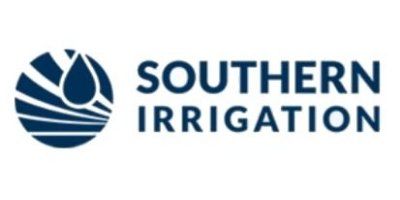
- Home
- Companies
- Southern Drip Irrigation Ltd
- Articles
- Subsurface Drip Irrigation: The Most ...
Subsurface Drip Irrigation: The Most Sustainable Water Solution for Drought Conditions in Canada
Many businesses in the prairies rely heavily on rain and melting snow for their water supply. But right now, Alberta and Saskatchewan are facing record-low precipitation.
The provinces of Alberta and Saskatchewan have struggled with droughts and water shortages for the last three years, and this year, the world is being hit with El Niño, which is causing the driest winter in seven years.
Since the beginning of January, these provinces have had less than 40% of the usual rain and snowfall, which has led to rivers running low, fields drying up, and minimal snowpack. Farms in Southern Alberta and Western Saskatchewan depend on river water to irrigate and sustain their crops.
Trevor Hadwen from Agriculture Canada said, “We have not seen any improvement in those conditions, whatsoever, in the last couple of months.”
The government’s Water Management Act has five stages. Currently, the Prairies are experiencing Stage 4 and 5 water restrictions, which directly impact residents and farmers.
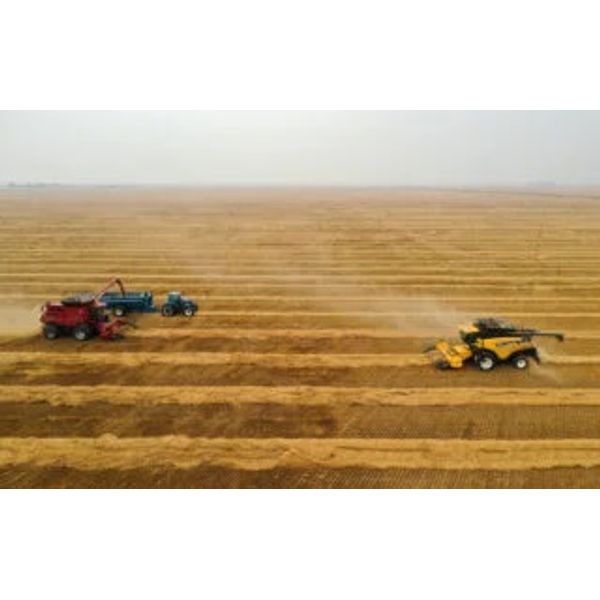
Stages 4 and 5 have the most strict water rationing.
At Stage 4, a significant number of licensees and traditional agricultural users in water management areas, including both large and small farm operations, are impacted and cannot access water diversion.
Moving to Stage 5, the low water supply raises the risk to human health and safety.
This means municipalities, water users, and Alberta government departments have been unable to address the magnitude of the water.
The good news is farmers who hold a license under the Water Act can be exempt. Check with your local authorities to confirm if you’re eligible for an exemption.
Depending on your landscape and needs, pivot and sprinkler irrigation may not be the optimal solution during drought conditions.
According to the Alberta Land Institute, irrigation licenses use 3.5 billion cubic meters of water per year and account for 60% of the province’s water usage.
Other than a few specific exemptions, diverting and using surface or groundwater in Alberta requires a license under the Water Act. It’s the responsibility of the water license holder to understand and follow the terms and conditions of their license.
Currently, 81% of Canada’s agricultural landscape is abnormally dry. During a water shortage, license holders can access water using three different methods.
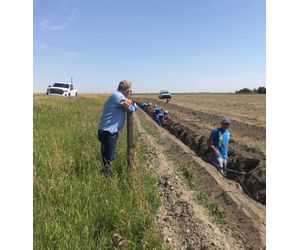
When there isn’t enough water in a particular basin to meet all of the licensees’ needs, a senior license holder may contact the department to administer priority rights.
For example, a licensee with an older license has the right to divert some or all of its allocation, subject to its license terms and conditions, before a newer licensee has access to that water. This is also referred to as being first in time, first in right.
This allows a licensee to temporarily assign all or part of the water allocation and priority under their license or to another licensee or traditional agricultural user for a set period.
This is where a license holder can transfer all or part of their water allocation to another licensee or new water user. Transfers are the primary method to enable water use in a river basin that has been “closed” to new allocations.
Alberta’s government has already begun meeting with major water users to develop voluntary agreements to share water if there is a severe drought.
This makes SDI the best irrigation method for optimizing water usage and enhancing crop health when there are water restrictions.
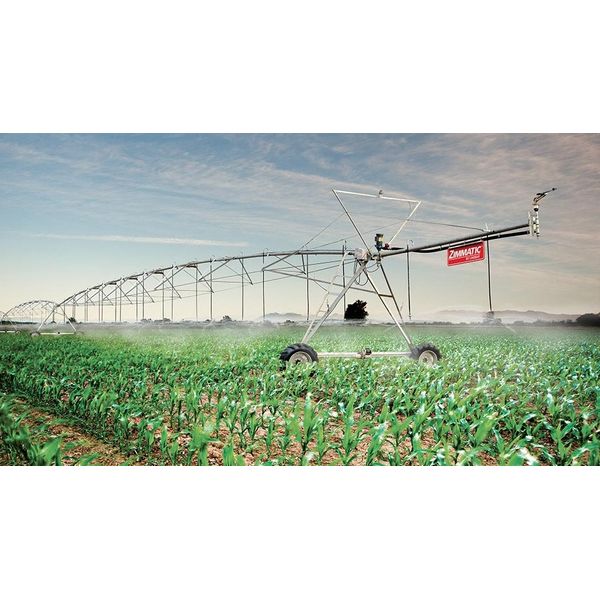
Effectively managing a farm during a drought presents significant challenges. The rules about water use change depending on how bad the drought is, which means having the right irrigation system becomes important to follow the water guidelines.
If you’re using a pivot or sprinkler system to water your crops, those quarter-section pivots usually shoot out around 3.0 to 3.4 mm of water per minute.
Imagine this: when a pivot completes a full circle over 24 hours, it applies 9.1 mm of water, and after factoring in an 85% efficiency, the net application comes down to just 7.7 mm.
85% efficiency with a pivot on a clear day is considered satisfactory for farmers. However, the efficiency of overhead irrigation is highly weather-dependent, with factors like wind significantly impacting their performance. On windy days, a pivot that was 85% efficient on a clear day may drop to 70% efficiency.
During a drought, your water usage is restricted to a specific amount. This means you might be permitted to utilize only 50% of the available water, and considering variables like weather fluctuations and other factors, your actual usage may be even lower.
This means that during a severe drought, every drop of water used to irrigate your crops matters, from delivery to absorption.
For these reasons, depending on your landscape and needs, pivot and sprinkler irrigation may not be the optimal solution during drought conditions.
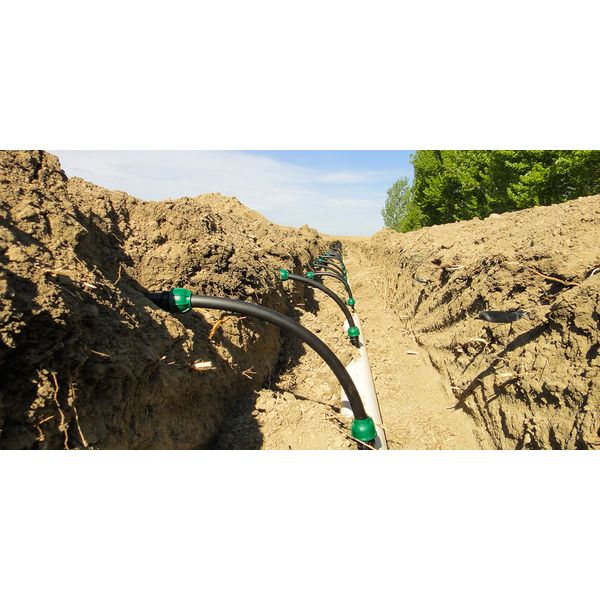
However, subsurface drip irrigation (SDI) provides very precise control over water delivery. SDI allows users to choose flow rates between .11 – .2 gallons (per hour) per emitter or more as needed.
This flexibility makes it ideal for diverse landscapes and crops, especially during droughts.
SDI efficiently delivers water directly to the root zone, consistently operating at a 96-98% water application rate. efficiency due to no evaporation loss, and since it is underground, that eliminates weather as a factor in its performance.
SDI’s underground tubing and emitters prevent evaporation and runoff and eliminate any weather factors in its performance. Despite common belief, it is low maintenance due to its fully automated system with an annual flushing cycle.
SDI promotes sustainable agriculture with minimal environmental impact, making it the best irrigation method for optimizing water usage and enhancing crop health when there are water restrictions.
“In Texas, there’s a nickname for SDI; it’s called 30/30/30.
30% less water, 30% less operating costs, 30% more productivity.”
– Lawrence Vandervalk, Co-owner of Valk Land and Cattle Ltd.
The initial cost of setting up subsurface drip irrigation is a higher investment per acre compared to overhead irrigation but in return, farmers get a stronger return on investment (ROI) due to increased yields and irrigable acres.
In the example below, we’re examining a quarter section in contrast to a center pivot covering 131 acres. Opting for SDI allows us to irrigate the entire 160 acres, effectively adding 29 acres to our irrigated land.
With SDI, we see a 10-15% average yield increase compared to a low-pressure pivot.
When we analyze a canola crop with a 10% yield increase due to the additional 29 acres that SDI covers, we see a yield improvement of 6.5 bushels/acre annually.
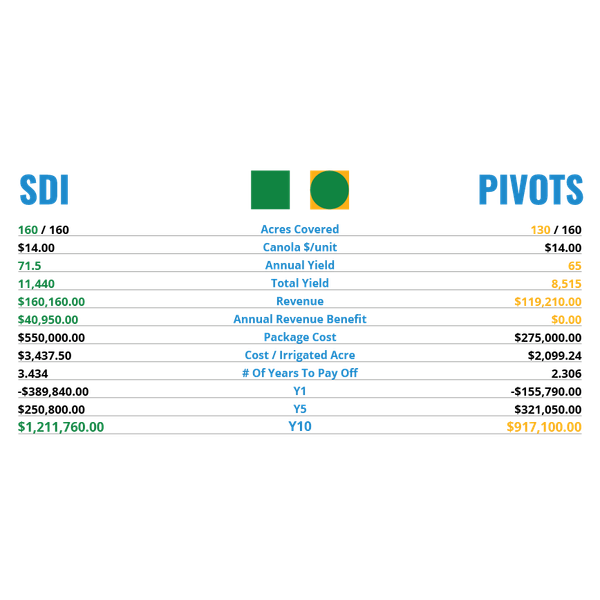
This results in +35% or $40,950.00 additional revenue each year ($160,160 SDI vs. $119,210.00 pivots revenue).
This ROI only considers the initial investment cost and crop revenue.
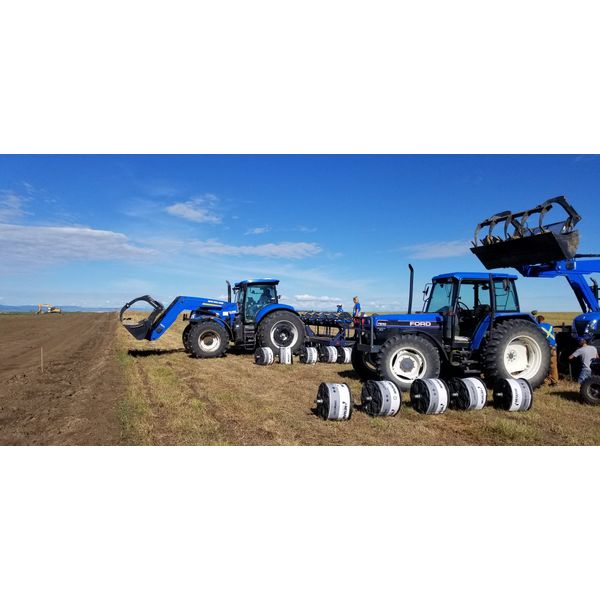
Valk Land and Cattle LTD. is a family farm owned by Lawrence and Sherry Vandervalk in Nobleford, Alberta.
In 2020, Southern Irrigation successfully installed a 625-acre SDI irrigation system. The installation process was smooth despite the dry and hard field conditions.
Despite starting irrigation in 2021 during extreme drought, Valk successfully replenished the soil profile with a minimal water usage at 10.5″ and cultivated a 100-bushel winter wheat crop.
In 2022, yellow mustard was seeded with a goal of growing 45 bushels/acre. Because of their confidence in SDI and the fast results they saw, Valk added an extra 160 acres to their system later that year. That brings the total to 785 acres that Valk Land and Cattle will manage using subsurface drip irrigation.
By delivering water directly to the root zone, SDI gives growers an effective way to minimize water usage and sustain crop production even throughout a drought.
With the impacts of climate change becoming a trend, farmers are regularly facing restrictions on water usage due to limited availability.
Although setting up an SDI system is higher in price, farmers get a stronger ROI because of increased yields and irrigable acres.
SDI presents an unlimited solution, allowing farmers to utilize the optimal amount permitted by the government and maintain successful crop growth regardless of environmental challenges.
